
Hafnium-Tungsten Chronology of the Ureilite Parent Body
46th Lunar and Planetary Science Conference (2015) 2293.pdf HAFNIUM-TUNGSTEN CHRONOLOGY OF THE UREILITE PARENT BODY. G. Budde1, T. S. Kruijer1, M. Fischer-Gödde1, A. J. Irving2, and T. Kleine1. 1Institut für Planetologie, Westfälische Wilhelms-Universität Münster, Wilhelm-Klemm-Straße 10, 48149 Münster, Germany ([email protected]). 2Department of Earth and Space Sciences, University of Washington, Seattle, WA 98195, USA. and the determination of Hf/W were slightly modified after [7, 8]. The HSE aliquots were purified by cation exchange chromatography [9] and the isotope dilution measurements were made on an XSeries 2 Q-ICP-MS. The W isotope compositions were measured on a Neptune Plus MC-ICP-MS in the Institut für Planetologie [10]. The W isotope data are normalized to 186W/184W (6/4) and reported as ε-unit deviation (i.e., 0.01%) relative to the bracketing standards. Repeated analyses of the terrestrial DTS-2B rock standard, which was digested, processed through the full chemical separation, and analyzed together with each set of samples, yielded a mean ε182W of 0.04 ± 0.08 (2 s.d., n=29) for ~30 ng W consumed per analysis. Results: Most ureilites (n=12) form a distinct cluster with 180Hf/184W < 0.1 and low ε182W values between –3.16 and –3.01 (Fig. 1). In contrast, six ureilites have higher ε182W values of up to –1.7, which are correlated with 180Hf/184W (except NWA 4474). The slope of this correlation line (MSWD = 1.6) yields an apparent initial 182Hf/180Hf of (1.21 ± 0.07) × 10–4, which is significantly higher than the solar system initial inferred from CAI [10]. Consequently, the correlation line cannot be an isochron and we interpret it to reflect contamination with terrestrial W during weathering in the desert. This is consistent with elevated Hf concentrations and W/HSE ratios in samples with less negative ε182W, and with the fact that all these samples are warm-desert finds. -1.7 NWA 4474 ε182W (6/4) Introduction: Ureilites are ultramafic meteorites consisting mainly of olivine + low-Ca pyroxene with interstitial graphite and metal [e.g., 1]. They are interpreted as residues left behind after extraction of both silicate and metallic partial melts, although they did not fully melt and differentiate [e.g., 2]. As such, ureilites provide an important link between primitive and differentiated achondrites and, consequently, can provide new insights into the earliest stages of planetary melting and differentiation. However, the chronology of ureilites and in particular the timing of melting and differentiation on the ureilite parent body (UPB) are poorly constrained. Until now, the most precise chronological information on ureilite formation is provided by Al-Mg and Mn-Cr ages of ~5–6 Ma after CAI formation, obtained for samples that are thought to represent the extracted silicate melt [3, 4]. However, these ages most likely are cooling ages and consequently do not provide the time of melt extraction and UPB differentiation. The short-lived Hf-W chronometer (t1/2 = 8.9 Ma) is well-suited to investigate the timescales of planetary differentiation and metal-silicate separation [e.g., 5]. Ureilites are characterized by strong 182W deficits relative to chondrites [6], consistent with an early differentiation of the UPB. However, the analytical uncertainties of available W isotope data for ureilites correspond to a range of ~10 Ma in the Hf-W model ages and, therefore, do not precisely constrain the time of UPB differentiation. We performed high-precision W isotope measurements on a comprehensive suite of ureilites to precisely determine the timing of UPB differentiation. The current sample set includes specimens from Northwest Africa and Antarctica, but additional ureilites from Almahata Sitta, including the trachyandesite ALM-A, will also be analyzed. The Hf-W data are supplemented by highly siderophile element (HSE) concentration data, to gain insights into the process of metal segregation and the bulk composition of the UPB. Methods: Bulk ureilite samples (~1 g) were carefully cleaned, powdered in an agate mortar, and digested in Savillex beakers with a HF-HNO3 mixture (180°C, 4d) followed by inverse aqua regia (130– 150°C, 2d). After digestion, small aliquots were taken for the determination of HSE (Ir, Ru, Pt, Pd), Hf, and W concentrations by isotope dilution. Methods for the separation of W by anion exchange chromatography -2.1 -2.5 -2.9 -3.3 0 0.3 0.6 180Hf/184W 0.9 Fig. 1. Hf-W isochron diagram for bulk ureilites. Samples shown in red are contaminated with terrestrial W. 46th Lunar and Planetary Science Conference (2015) 1.3 Bulk ureilites (this study) Grain boundary metal IVB irons (parental melt) X/Ir (CI) 1 2293.pdf ages date cooling of lava in near-surface areas, whereas the Hf-W model dates the earlier extraction of a Hf-rich silicate melt, i.e., the time at which radiogenic ingrowth of 182W virtually stopped. ALM-A (Al-Mg) 0.7 feldspathic clasts (Al-Mg) NWA 766 (Mn -Cr) this study (Hf-W) 0.4 IVB irons (Hf-W) magmatic irons (Hf-W) 0.1 0 Re Os W Ir Mo Ru Pt Rh Pd Fig. 2. Average abundances of refractory siderophile elements in bulk ureilites (Os after [11]), ureilite grain boundary metal [12], and IVB iron meteorites [13]. HSE concentrations are sub-chondritic to chondritic and characterized by marked depletions in Pd, consistent with earlier studies [11]. In several samples W is depleted relative to refractory HSE, consistent with results of in situ measurements of grain boundary metal [12]. The HSE systematics do not show any obvious correlation with ε182W, indicating that ureilites do not contain different populations of distinct metal components formed at different times. Discussion: Twelve of the investigated ureilites show no evidence for modification of ε182W by terrestrial weathering and define a narrow range of initial ε182W values with a mean of –3.13 ± 0.11 (2 s.d.). Provided that these ureilites formed from a chondritic reservoir, their mean ε182W corresponds to a two-stage model age of 3.3 ± 1.2 Ma after CAI formation. However, ureilites display fractionated patterns of chondrite-normalized refractory siderophile element abundances with marked depletions in W and Mo (Fig. 2). This pattern is very similar to the projected parental melt composition of IVB irons and may, as for the IVB irons [e.g., 13], indicate high-temperature processing of the ureilite precursor material in the solar nebula, resulting in a depletion of W (and Mo) relative to other refractory siderophile elements. If this is the case and if the non-chondritic composition of the ureilite precursor material was established at the beginning of the solar system, then the UPB would have evolved with a super-chondritic 180Hf/184W of ~1.7 prior to differentiation. This would result in a slightly older calculated Hf-W model age of 2.6 ± 0.9 Ma (2 s.d.). Either way, the Hf-W age is older than the ~5–6 Ma Al-Mg and Mn-Cr ages for feldspathic clasts from polymict ureilites and the trachyandesitic specimen ALM-A (Fig. 3). This is consistent with the idea that the latter 2 4 6 ΔtCAI [Ma] Fig. 3. Hf-W model age for ureilites compared to cooling ages [3, 4, 14] and magmatic iron meteorites [15]. Assuming a CV-chondritic Al concentration for the UPB, thermal modeling indicates that, to reach the melting temperature at 2.6 Ma, the UPB would need to have accreted at ~1.4 Ma after CAI formation. Thus, the UPB seems to have accreted and differentiated slightly later than the parent bodies of magmatic iron meteorites [15]. Nevertheless, accretion was early enough to lead to complete melting, yet the UPB did not differentiate completely. This most likely reflects removal of 26Al from the ureilite source region together with the extracted silicate melt [e.g., 11, 16]. To further investigate the effect of terrestrial contamination on Hf-W systematics, we will analyze fresh ureilite finds from Almahata Sitta. We will also present Hf-W data for the trachyandesitic specimen from Almahata Sitta, which is thought to represent the extracted silicate melt. The ALM-A sample should make it possible to constrain the timing of UPB differentiation more precisely and also largely independent of the bulk composition of the UPB. References: [1] Goodrich C.A. et al. (2004) Chemie der Erde, 64, 283–327. [2] Warren P.H. et al. (2006) GCA, 70, 2104–2126. [3] Goodrich C.A. et al. (2010) EPSL, 295, 531–340. [4] Bischoff A. et al. (2014) PNAS, 111, 12689–12692. [5] Kleine T. et al. (2009) GCA, 73, 5150–5188. [6] Lee D.-C. et al. (2009) EPSL, 288, 611–618. [7] Kruijer T.S. et al. (2012) GCA, 99, 287–304. [8] Kleine T. et al. (2012) GCA, 84, 186–203. [9] Fischer-Gödde M. et al. (2010) GCA, 74, 356–379. [10] Kruijer T.S. et al. (2014) EPSL, 403, 317–327. [11] Rankenburg K. et al. (2008) GCA, 72, 4642–4659. [12] Goodrich C.A. et al. (2013) GCA, 112, 340–373. [13] Walker R.J. et al. (2008) GCA, 72, 2198–2216. [14] Yamakawa A. et al. (2010) ApJ, 720, 150–154. [15] Kruijer T.S. et al. (2014) Science, 344, 1150–1154. [16] Wilson L. et al. (2008) GCA, 72, 6154–6176.
© Copyright 2026
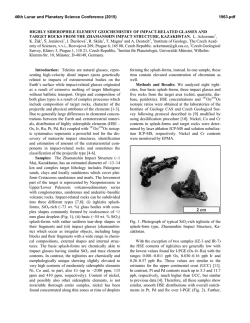
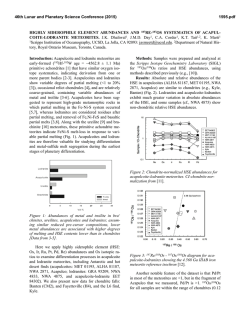
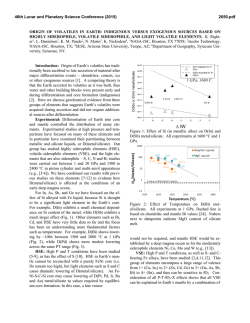


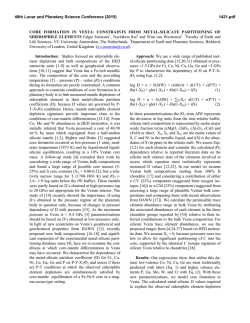
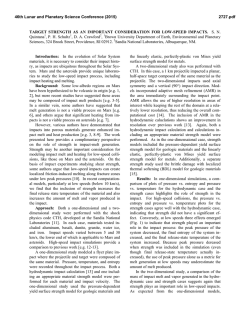
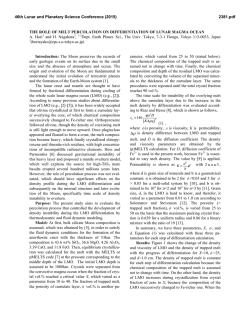
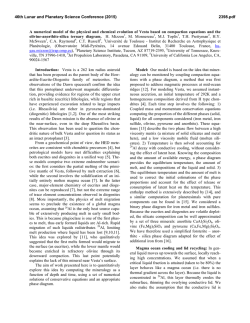
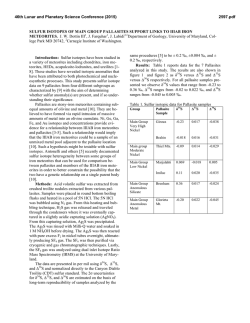
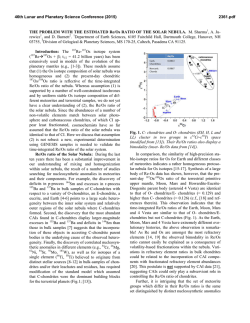
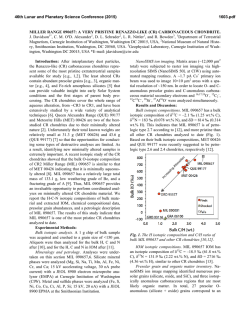
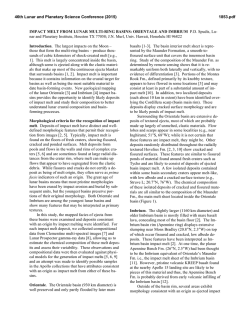
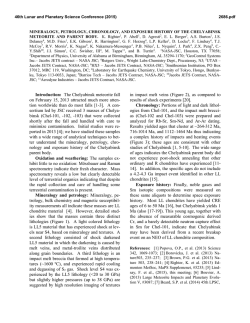
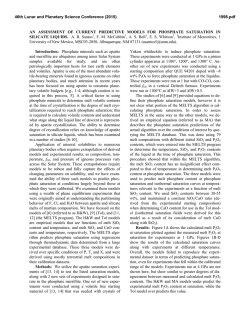
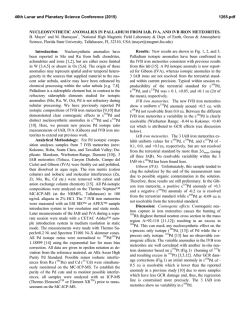
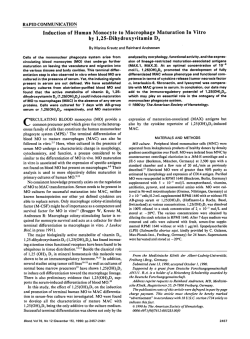
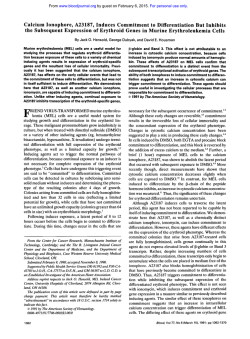
![Young Persons Guide to BCPL Programming on the Raspberry Pi [pdf]](http://s2.esdocs.com/store/data/000468139_1-2843007f0c82b69dc01e16a6dc45f2ba-250x500.png)